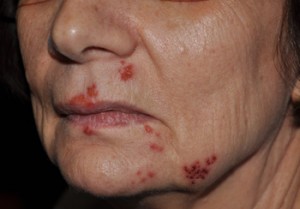Did you know that over 80% of people in the United States have been exposed to herpes simplex 1 virus (oral herpes) and 20% to 40% of these people will experience an outbreak of cold sores of some frequency. Once a person becomes infected with the virus it stays in their body for life, lying dormant in the nuclei of the trigeminal nerves. Cold sores occur mainly on the lips and around the mouth but can also be seen to erupt on the cheek, chin and even the nose.

Reactivation of the herpes simplex 1 virus by laser resurfacing can not only cause a cold sore to reappear, it will most likely cause multiple lesions or a crop of blisters to appear. The raw surface of newly resurfaced skin makes a fertile environment for the spreading of cold sores. Usually the size, extent and duration of the cold sores will be even greater in the face of laser resurfacing than just a typical outbreak. If extensive enough, scarring may even be the sequel of a laser resurfacing-induced outbreak.
Laser resurfacing patients should always be asked if they have a history of cold sores prior to these treatments. If a patient does have a history of cold sores (herpes) they should be put on an antiviral medication for a minimum of one week prior to treatment and one week after treatment to prevent the reactivation of the virus. Even with before and after laser resurfacing antiviral prophylaxis, some patients will still develop some virus outbreaks but it will be smaller and will heal quicker.
Antiviral medication options for treatment of cold sores (herpes) are Acyclovir (Zovirax) 200mg by mouth, four times a day for five days (pre and post treatment) and Valacyclovir (Valtrex) 2 grams by mouth, every 12 hours for one day (pre and post treatment). The cost differential between the two is one of the main deciding factors when choosing which antiviral medication is chosen. Acyclovir is approximately $10.66 without insurance to fill for the needed amount, while Valacyclovir is approximately $50 without insurance.
In addition to oral antiviral medications, there are also topical antiviral creams that can be applied. This may be beneficial to use with the oral medications prior to treatment if the patient has a lesion or blister present, but would be most beneficial for after treatment especially if some outbreak occurs. Abreva (composed of 10% Docosanol) is sold over the counter for approximately $14.21 a tube and is applied directly to the cold sore five times a day. Denavir (Pencyclovir) is a prescription cream that is applied directly to the cold sore every two hours for four days and costs approximately $103.98 per tube. The use of both topical and oral medication together will help the virus heal quicker.
An interesting question is whether all perioral laser resurfacing patients should be put on antiviral medication even if they have never had cold sores. There are some patients who develop cold sores after laser resurfacing even though they have no prior history. There is no established standard of care that says such prophylactic medications should be used when no herpetic history exists.
Dr. Barry Eppley
Indianapolis, Indiana


